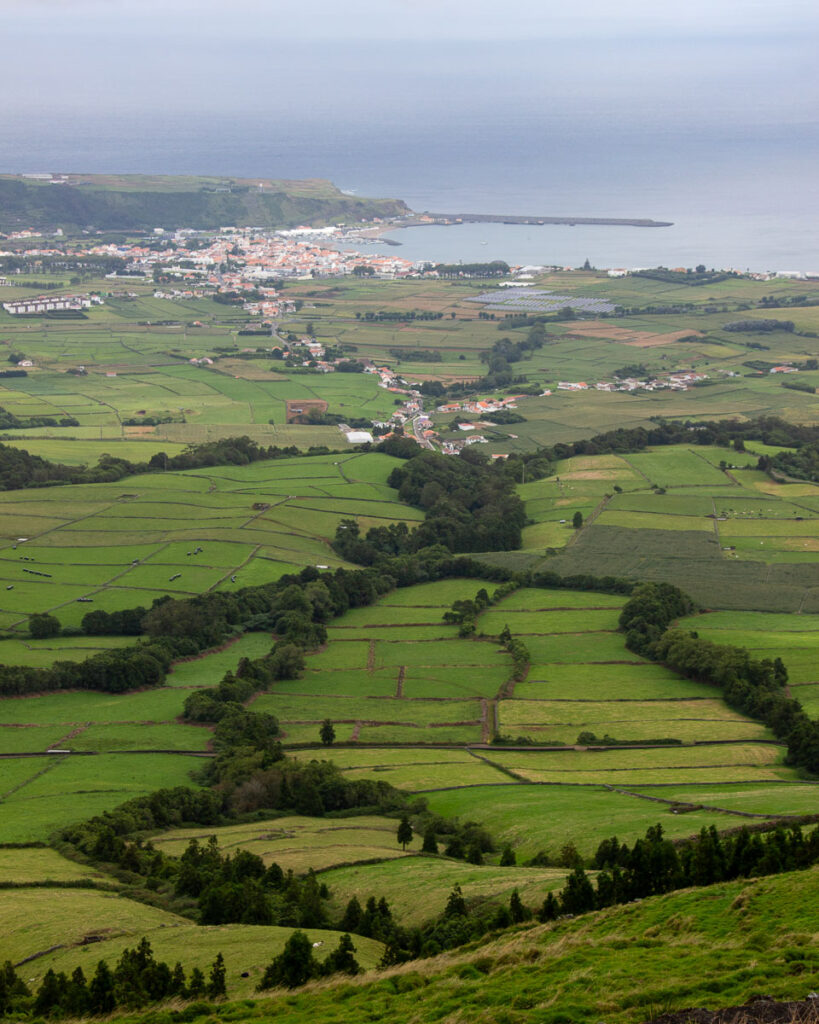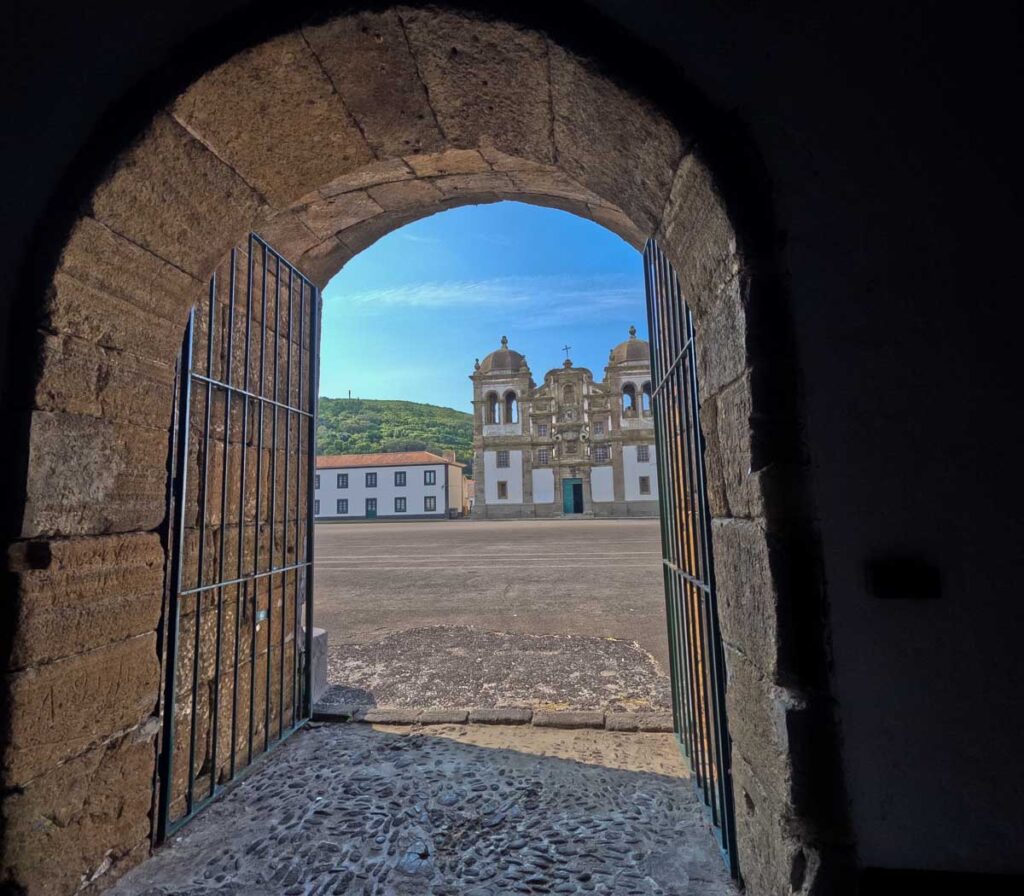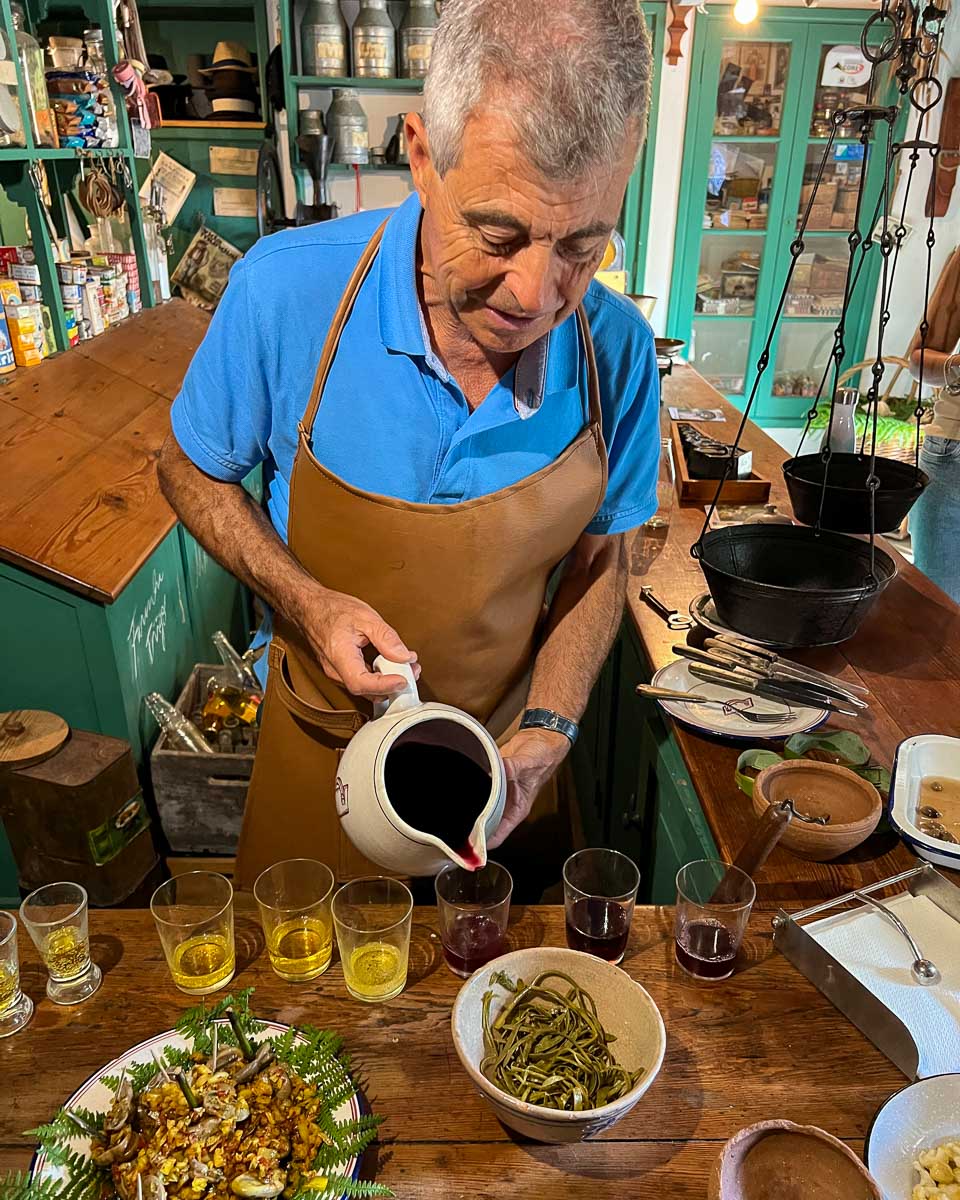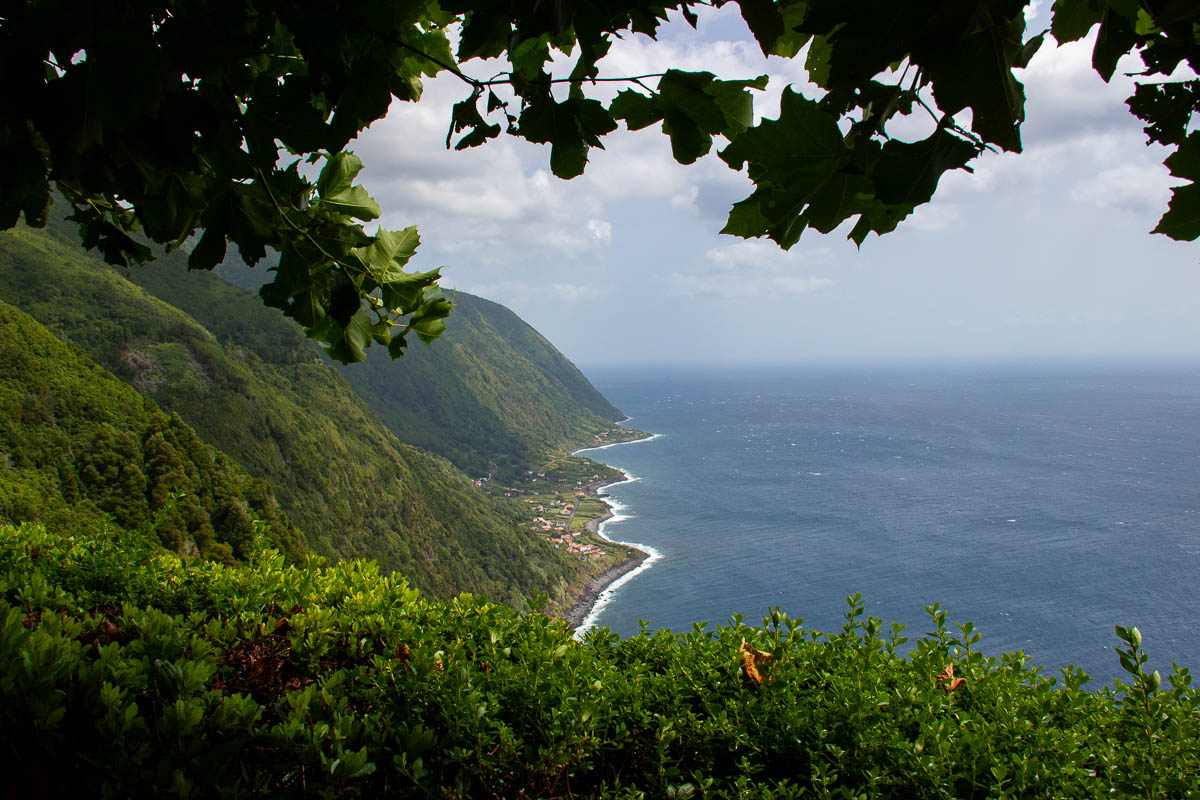Thinking about a Trip to the Azores? Read this first.
Still one of the best hidden gems in Europe, especially as a nature destination, the Azores are a beautiful place to avoid crowds and get off the beaten path. These Portuguese islands make a great summer trip (and are even quieter in the spring and fall). This article is an overview of what to know before planning your trip to the Azores, and how to make it more sustainable. (I also have a detailed itinerary for visiting Terceira.)
Note: I wrote this article after a sponsored press trip. Still, my opinions are my own. See below for details.
Visiting the Azores for the first time was one of those trips that felt like stepping into another world.
These nine small islands in the middle of the Atlantic are the western-most part of Western Europe. They’ve played an outsized role in European history, yet visiting them feels like stepping off the edge of the map, tumbling through a rabbit hole, and popping up in a kind of… subtropical Iceland?
But one that’s glowing green like Ireland, and scattered with hiking trails and cows. With deeply surprising traditions, festivals, attitudes and religious beliefs that reminded me slightly of… Central America?
It really felt more disconnected and surprising than I expected. And also profoundly quiet, humble, and serene.
When I first checked into my small hotel, it seemed like a chic wellness retreat – one with a glowing green front lawn, and a quiet pool with a view of the Atlantic in the distance.
The modern, elegant furniture in my suite was intriguing enough that I wanted to find a way to fit it into my suitcase. When I opened my bedroom window the first morning, cows were quietly munching on grass in the morning glow outside. I could almost reach out and touch them.
And this clean, fresh, humid air just made the place feel so healthful.



But after a few days, I realized it wasn’t just the hotel that felt like a retreat. It was the whole island of Terceira. A restful, soothing place where you have almost no option but to let yourself relax and let your batteries recharge.
And that must be one of the things that keeps the Azores so unique and special – these islands are not for everyone.
They have very few sandy beaches – but having to lay their towels on a seaside strip of concrete (or a lava flow) doesn’t keep Azoreans from the water!

There’s no night life to speak of. (The largest island of São Miguel would be the only place to hope for much, but if you’re looking for a trip that involves clubbing, the Azores shouldn’t be your first pick.)
The buildings are almost beautifully shabby, and the whole place is very low-key in a lovely way. In short, there’s very little drama here.
A bit of Azorean History
While nature is undoubtedly the main attraction in the Azores, there’s also some fascinating European history to see, and lots of culture. (I spent an evening at a local festival in a small village that I certainly won’t forget.)
The Azores have been part of Portugal for centuries, minus about 60 years under Spanish rule. For a couple of years around 1580, the small port town of Angra do Heroísmo was even the Portuguese national capital, after being the only place in Portugal to successfully repel the initial Spanish invasion. Two years later, though, the islands did fall to Spain.

The story of this period – about a woman named Brianda and the herd of bulls she released to attack the Spanish invaders – is part of what it means to be Azorean.
Herds of bulls are still an important part of life on the islands, where local beef, local fish, and local cheese are the staples of just about every menu. (Note: The Azores won’t be the easiest place for vegan travelers, or even vegetarians. But if you enjoy seafood, you’ll be in heaven.)

Out of the pastures, these islands were a rare safe harbor in the mid-Atlantic for centuries of sea trade. The town of Angra do Heroísmo, which was our home base on the island of Terceira for 7 days, has been an important hub for centuries. It was where Vasco da Gama brought his dying brother in the late 1400s, because the town had the only hospital in the Atlantic.
(Even today, only three of the nine islands have hospitals – Terceira, São Miguel, and Faial.)
And what exactly is an Azore, anyway?
It’s a kind of falcon, as our excellent guide, Pedro, explained. And it’s featured on the Azorean flag – despite none of them living in Azores. (And happily, for once, this isn’t a story of a species being pushed out. As far as scientists can tell, there never were any azores in the Azores.)
(This is the full-day tour you should book to get our guide or his colleague. Here are the other tours from his company. It’s a small local business on Terceira, and he was one of the best guides I’ve ever had!)
And one of the best-known symbols of the islands is the hydrangea – you’ll see them flowering everywhere in the summertime. (But they’re originally from Japan.)

That’s the surprising kind of special place these islands are. At first glance, they simply don’t make sense.
As someone who lived in Western Europe for several years, I thought I knew more or less what to expect on this part of the continent, but the Azores don’t fit the mold in many ways.
The next Iceland?
However, the Azores did remind me of a lot of other beautiful places I’ve visited, perhaps most poignantly Iceland. Both are volcanic islands in the Atlantic, with intense, dramatic landscapes. Both have recently emerged, to some extent, from centuries of relative poverty on the fringes of Europe.
And the Azores are following in Iceland’s footsteps and using “stopover” flights as a way to increase tourism. (Travelers can book flights between mainland Europe and North America with the option to add a few days in the Azores.)
After all, it’s on the way. And as far as sustainability is concerned, if you would have needed a layover anyway, and can replace a useless one with a beautiful experience, it’s a win-win. I’ve written about this before in another Portuguese destination – Porto.

Are the Azores a sustainable destination?
This is one of the questions I get most often, as a sustainable travel writer, and it’s usually a complicated one to answer with real meaning.
First, yes, the Azores are mostly a nature destination, and probably one of the best eco-tourism destinations in Europe. Does that mean they’re automatically a sustainable destination? No, because just taking place outside doesn’t make an activity sustainable.
But in this case, it does mean that people are traveling to the Azores not to spend money in over-airconditioned, foreign-owned beach resorts, to shop international fashion brands, or for any kind of mass-tourism.
Still, it’s a destination that’s impossible to reach without flying. (Unless you’re planning to sail there like Vasco da Gama, in which case, more power to you! And call me. Otherwise, see below for flight info.)

Over-tourism?
The fact that the similarities with Iceland seemed so obvious made me nervous about the future of tourism here – the thought that the Azores, too, could quickly turn into an unsustainably popular tourism destination. (Iceland is one of the modern poster children of over-tourism, with 2 million visitors a year in a country of less than 400,000 residents.)
Right now, that’s blissfully hard to imagine. Almost everyone I met in the Azores seemed genuinely happy to see tourists.
For just one example, I was wandering around one morning in Angra, minding my own business and marveling a colorful império – a uniquely Azorean kind of chapel devoted to the Holy Ghost. (Holy Ghost worship is the defining belief of Azorean religion, and the only religious tradition that’s common to all nine islands.)
And while I marveled, a stranger volunteered to snap a picture of me in front of it. I think my eyes are closed, and the top of the building is chopped off, but I kind of love it.

That kind of thing just doesn’t happen in places like Venice or Paris, where local people are overwhelmed by too many tourists.
But the appeal of the two places – the Azores and Iceland – is similar. Both feel like dramatic, remote, spacious, places where the main appeal is nature and, frankly, avoiding other tourists or… any people. At least major crowds of them.
What matters most: How you get there & how you spend your money
So as always, when trying to travel more sustainably, there are lots of simple tips that make a big difference. First, choose a lower-emission flight route. (As I describe below, I was able to fly to the Azores directly from New York City – no need to go all the way to Europe first – on one of the most efficient planes in the world.)
After you arrive, the most important factor is who you spend your money with. (Keep it local, and skip the chain hotels and restaurants!)

Without tourism, the economy of the Azores is almost entirely agriculture and fishing, and the region still has a higher rate of poverty than the rest of Portugal.
So this is a place where your travel budget is appreciated, and where it’s easy to spend money with local businesses.
And they’re almost all local businesses on the Azores. Chain hotels or fast-food restaurants aren’t really a thing here. (That means it’s quite easy to eat mostly locally produced food – although as a food culture based on cows and the sea, it’s not an easy place to be vegan, or even a casual flexitarian like myself.)
So I have to say, if you’re thinking about visiting the Azores, I would think about going now instead of waiting five years – just in case any of this starts to change.
Beyond economics, you can control lots of other sustainability factors with a few habit changes:
- Eat and drink whatever is locally produced.
- Purify your own water if you can’t drink tap (but in the Azores, you most definitely can).
- Order less meat – especially beef, which has by far the highest climate impact. (Although here, where cows are grass-fed and very local, is probably one of the best places in the world to indulge.)
- Pack less.
- Take public transit. (Which is limited in the Azores, but keep it in mind for elsewhere.)
- Bring plastic-free toiletries.
- Choose trains and ferries over flights.
- And whenever possible, move slower and stay longer.
[For more on all of these points, check out the articles linked above, and my Lazy Guide to Sustainable Travel.]
Getting to the Azores
From some parts of North America, the Azores are surprisingly easy to reach – although I wouldn’t have guessed it from the sparse tourists I saw there in early September.
If you’re in North America, SATA Azores Airlines has direct flights from five cities in North America straight to the Azores. (From the East Coast, it’s about a 6-hour flight.)
As someone who often chooses her destinations based on direct flights, to reduce carbon emissions, this was a useful tip!
Important tip: Ferries and flights between islands in the Azores are seasonal, and even in the high season, they’re not every day. So when you start planning your trip, check the schedules sooner rather than later.
Direct flights to the island of Terceira, where I spent more of my time in the Azores, are from Oakland, JFK and Toronto.
Direct flights to Ponta Delgada, the Azores’ largest city, on the island of São Miguel, below, are from JFK, Toronto, Boston, and Montreal.
Flights from JFK, Boston and Toronto depart throughout the year. From Oakland, they’re from June through September, and from Montreal only in July and August.
PIC – Skyscanner widget








Can you go and just hike, or are they all part of tours? We are self-proclaimed sloth hikers, and like to take our time, and look at everything! Lol any insight would be appreciated. Have a great day!
Hi Ken,
Haha I like the term “sloth hikers,” and I understand, I’m the same sometimes. If you take the “scenic hiking tour” with Pedro, our guide who I recommended, then yes, you’d probably have to keep a bit to his schedule (although he was quite flexible with our very slow and didn’t rush anyone). But you can also do these hikes on your own if you prefer!
I’d definitely recommend doing one of Pedro’s other tours, though. He and his colleague were absolutely fantastic guides, and we learned a lot about the city of Angra and the island.
Also, I’ll be publishing a more detailed guide to Terceira soon, so if you’re interested in that, please keep in touch!
Cheers,
Ketti
Hi Ketti,
My wife and I are looking at a visit to the Azores in Sept- Oct this year. I note you were there in September while it seemed relatively quiet. We typically prefer the quiet season to enjoy the nature etc. You didn’t mention much about the weather while you were there? I understand it can change quite quickly?
Appreciate your response.
rgds
Stuart Stanley
Hi Stuart,
That’ll be a great time for a visit! When I was there (first week of September) it was definitely already changing quickly. Most days I wore shorts but kept a light jacket on hand for wind. It was really perfect hiking weather – warm enough but not hot. And the water was still surprisingly warm for swimming, which was great. I hope that helps!
Also, if you want to keep in touch, I’ll be publishing my guide to Terceira very soon, with a lot more detail on hotels, restaurants, and other recommendations on the island!
Hope you have a great trip and let me know if you have other questions!
– Ketti
we are considering a 2 week vacation to the azores. we are departing from miami. how do you feel about 2 weeks? is it too long, and should we consider adding a couple or so days in lisbon or elsewhere? thanks for your comments.
Hi Nicole,
Sorry it took me so long to get to you here! Honestly, it depends on what kind of trip you’re looking for and what your travel style is. Do you like to take it easy, not cram too much into each day, kind of a slow travel vibe? Then you could easily spend 2 weeks in the Azores – especially if you want to island hop and visit 2 or 3 or even 4 islands (I talk about this a bit at the end of my Terceira island guide). And if you love hiking / trail walking / biking, then there are tons of options in the Azores to keep you entertained for two weeks. You might even think about splitting up two islands with lots of outdoor time with a visit to Pico, where they have lots of wineries and you could do some wine tastings.
But at the same time, flying out of Miami, you have to have a layover in Lisbon or Porto anyway, and if you’ve never been to those places, they’re both definitely worth a few days, and it makes the extra flight feel like less of a waste! (I wrote a guide to a layover trip to Porto that you might want to check out, and I’m working on a guide to planning layover trips, too, so stay tuned for that.)
I hope that’s helpful! Let me know what you end up doing and if you want, please do keep in touch!
– Ketti
I lived on Teixeira for 2 years and it was my favorite place. Great memories!
I’m not surprised, Maureen! It seemed very easy to love. 🙂 I’ll be publishing a guide to the island soon, with lots of recommendations – I’d be curious to hear what you think! If you’re interested, please do keep in touch!
Cheers,
Ketti
What an enjoyable and informative article! I feel like I learned enough to book a trip to the Azores!
The humor and personal perspective was engaging and comfortable. I’m all for tourist free vacations and landscape eye candy!
Thank you! I’d love to read more of your insights!!
Thank you so much for your feedback, Anna! That really makes my day. 🙂 Let me know if you ever have any questions I might be able to help with, and please do keep in touch!
Also, FYI, I’ll be publishing a more detailed guide to Terceira soon, with hotels, restaurant recommendations and all those details – in case you really are ready to book a trip!
Cheers,
Ketti
Thank you,
I’ve been thinking about the Azores for years. It’s our idea of a break from our routine.
Thank you , it’s just right.
Hi Richard and Janice,
Thanks, I’m so glad you found the article helpful! Let me know if you have any questions I might be be able to answer as you’re planning your trip. And if you’re interested, please do keep in touch!
Cheers,
Ketti
Yes I would like to retire there buy some property maybe a bed and breakfast. I live in NY and have horses. Do you have any idea what it would take to be a resident and are horses allowed on the islands?
Terceira has no night live? lol you should have found a local guide.
Terceira is known for being a party island and night life. 🤦🏼♀️
As described in the article you’re LOLing about, we did have local guides. I suppose it depends on your definition of “night life,” but compared to party destinations in Spain or other parts of Portugal, Terceira feels calm and quiet. There were no beaches lined with bars and clubs in Terceira.
From Boston, it is about 5 hours, not 6!
I lived in Terceira when I was 14. I’m now 70 years old. My step father was in the Air Force. It was beautiful. I still miss the bread and Portugese steak.
Great writing! Two Canadians interested in sites, locals, whales, no tourists. Is it too late to consider a 2 week trip for this Sept? Suggestions appreciated
Hey there, thank you! I’m so glad you enjoyed it!
I would say it’s definitely not too late (but I’m a notoriously last-minute travel booker. 🙂 ) Have you seen my guide to Terceira? I really loved that island, and it’s full of all my favorite recs. Hope that helps! And if you’re interested in more, please do keep in touch!
– Ketti
Fabulous – thank you. I am looking for help in planning a fun, active, and low-impact trip with my family – grandparents, children, and grandsons (ages 6, 8, 10) for April 2025.
Hi Rose,
Thank you so much, I’m so glad you enjoyed the article! Fun, active and low-impact is everything I’m about, and the Azores are definitely a great spot for it. Have you already seen my guide to Terceira island? If not, that might help with the planning.
Or if you’re open to different destinations, I did an e-bike trip in Italy’s Marche region last year that would definitely fit the bill!
And I’m actually leading a version of that same trip in September, which has just a couple more spots open. But if you wanted to do that trip just with your family (not a group trip with strangers) you could definitely also do that. There’s more info about it here. Marco is a fantastic local guide so you’d be in good hands.
I hope that’s helpful (not that you asked for help!). If you’re interested, please do keep in touch!
– Ketti